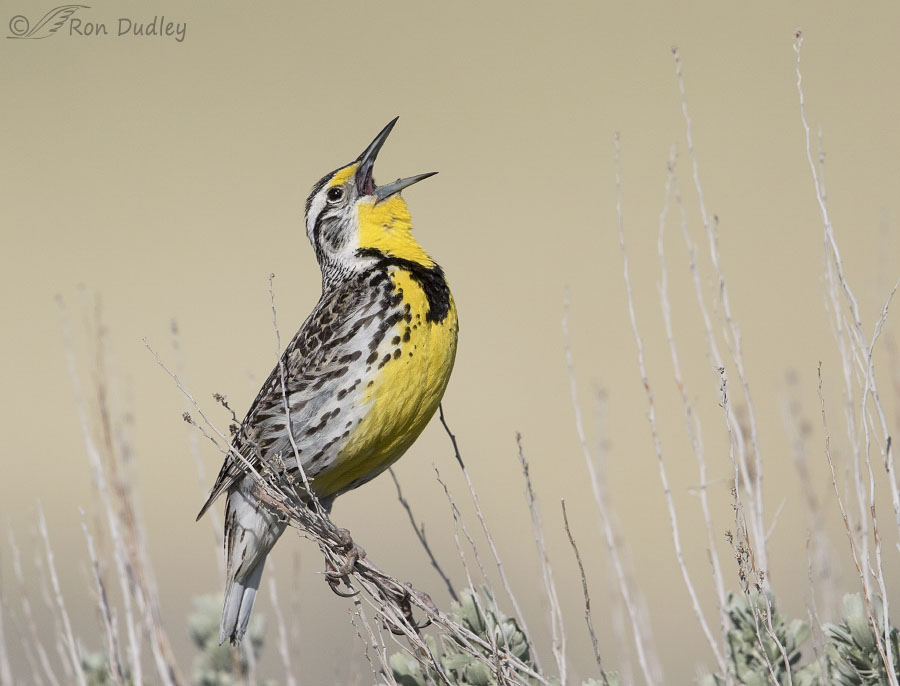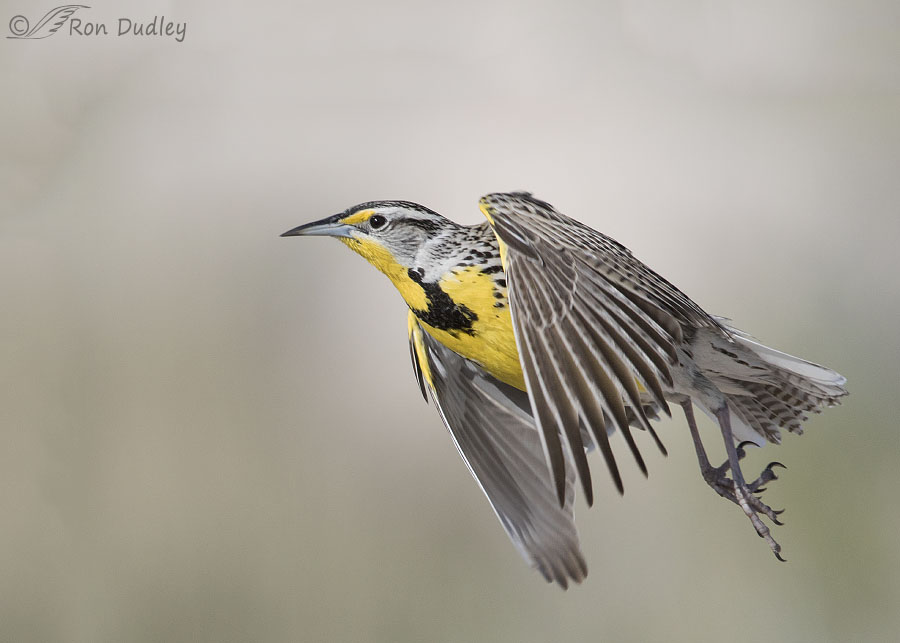Meadowlarks often perform a pretty neat little trick while they’re landing on sagebrush.

1/8000, f/6.3, ISO 500, Canon 7D Mark II, Canon EF 500mm f/4L IS II USM + EF 1.4 III Extender, not baited, set up or called in
I photographed this singing Western Meadowlark three days ago on Antelope Island. The photo is fairly typical of a meadowlark in springtime because this time of year they’re such inveterate singers but there’s something interesting about that perch and how the bird got there.
In some habitats preferred by meadowlarks sagebrush is one of the few perches available to them but they’re heavy-bodied birds whose weight normally can’t be supported by those spindly vertical twigs left over from last year. But there’s one trick (if they can manage it) that will allow them to perch on them. A single twig or even several won’t support their considerable weight but a half-dozen or more pulled together by their feet into a clump will get the job done. The question becomes how do they manage to pull that many twigs together during the landing process? Most of them really aren’t that close together.
I often see them hover very briefly over the twigs while landing but that’s usually from a distance and the purpose of them doing so was unclear until I thought about it after seeing many close-up photos of them perched with large clumps of sagebrush stems grasped in their feet. They must be hovering briefly to gather in enough stems with their feet to support their weight.
And I think that’s a pretty neat little trick for any bird but especially for one that’s so chunky and not normally known for its agility in flight.
1/5000, f/6.3, ISO 500, Canon 7D Mark II, Canon EF 500mm f/4L IS II USM + EF 1.4 III Extender, canvas added for composition, not baited, set up or called in
About an hour after the previous shot was taken I photographed this meadowlark soon after takeoff. The photo reveals what may be one of their adaptations for gathering in groups of sagebrush twigs during the landing process – long legs and long, spindly toes with sharply curved claws that seem perfectly designed for accomplishing that daunting task while they’re briefly hovering.
Some of what I’ve said above is only speculation on my part but it makes sense to me. I can’t help but wonder about this kind of thing as I observe birds in the field and then attempt to put pieces of the puzzle together as I look at my photos.
Ron
PS – And here’s some more speculation. Occasionally when I see a meadowlark hovering briefly over sagebrush it gives up and flies off instead of landing. Perhaps that’s because they’ve failed in their attempt to gather in enough twigs to support their weight? It can’t be easy to do…



Great photos Ron. Love Meadowlarks and especially their song. They are very plentiful here and pretty much year round. Always reminds me of the late great Meadowlark Lemon Golbetrotter great for so many years. Enjoy the weekend.
Everett Sanborn, Prescott AZ
Science has proven that birds do indeed have great intelligence and your theory has validity for sure.Lovely images.
Your theory sounds eminently reasonable. And that is an incredible skill to master, hovering AND creating a secure perch. Simultaneously? Bird-brained is not a criticism. Or shouldn’t be.
“Bird-brained is not a criticism. Or it shouldn’t be”.
I strongly agree, EC. It’s inaccurate, just like “eat like a bird” is. Birds are typically far from dainty eaters.
Both shots are fabulous! Such bright birds! Love all the positions in the second shot. Those “rear” claws are really something — remind me of talons. That longer and extra-curved claw must really help in gathering the twigs.
Marty, those legs, toes and claws are so long I’m constantly cutting them off in my meadowlark shots. Sometimes they’re hard to see in the perch they’re using and I just don’t think about my composition as carefully as I should.
You definitely nailed the composition on both of these shots, Ron!
Very interesting Ron. I am sure you are keeping your eye out, and camera ready to capture some images when they are hovering above the sage. I will do the same (although in our area they are very skittish and not as common as I would like).
That’s a very hard shot to get, Ed. Gonna try though, if I ever have the opportunity. Thank you.
Beautiful photos. I can almost hear the song emanating from the bird in the first photo.
Thank you, Lyle.
Ron,
Interesting theory. Just one of the many things I like about reading your blog. I went to Antelope Island yesterday and now my head is covered with little bumps that are driving me crazy. Those blasted bugs (no see ups?) are murder. I don’t know how you can tolerate it. I may have to wait until winter to go back!!
Signed,
“Itchy and Scratchy”
Stephen, To say that I “tolerate” them is probably a bit of a stretch. They’re truly nasty critters, aren’t they!
Oh how I wish I had meadowlarks here! Their song delights my soul!
It looks to me that your supposition is probably correct and oh what an outrageous adaptation! I hope you can document it soon. Of course, the first step to documenting a behavior (generally) is realizing that it’s possible. The other first step is catching the behavior serendipitously.
I wish redtails would get that. They really like perching at the tippy top of an evergreen tree on tiny branches that cannot possibly hold their weight. The branch bends, sometimes as much as a foot or so, and they usually get away with it. I guess that’s why they haven’t changed that particular behavior. If it ain’t broke…
Trying to get the “follow” notification. It’s not coming yet. Darn computers anyway!
Laura, I’d really miss them if we didn’t have meadowlarks around here.
Now that you’ve “wondered”, it’s only a matter of time until you see ( and hopefully photographed ! ) the answer to this interesting question–I’m so glad you never left your”wonder years”
behind ! I don’t even understand the question of “boredom”–the solution is so simple– CURIOSITY !
Indeed Kris! I don’t think I’ve ever been bored in my entire life. There’s always something to do, read, watch, or just wonder and ponder! I can’t even imagine being bored. How does THAT happen? LOL!
Me too. Curiosity is one of my defining characteristics. And there is soooo much to learn.
I hope I can document it one day, Kris. However, landing shots are incredibly difficult to get…
Keen observation, Ron, and an inspiration to watch birds’ behavior very closely — and consider how to interpret it.
Thank you, Paul.
Fantastic shots and very interesting info Ron.
Charlotte
Thank you, Charlotte.
Strikingly beautiful images of the meadowlark, Ron! Here in south Florida, Purple Gallinules relish the fruit and flowers of the Alligator Flag. They are on very tall and thin stalks. In a somewhat similar manner the gallinule grasps several stalks close to the ground with its very long toes and uses the construction principle of “triangulation” (best exhibited in the Eiffel Tower) to simply “walk” up to the topmost branches.
Interesting similarity between the techniques of both birds, Kenneth. Thanks for that feedback!
Interesting! They certainly do have long legs/toes. Never paid any attention given fence posts are the preferred perch in this area. They are slow to arrive this year………
Thanks, Judy. Fence posts are few and far between on the island so sagebrush (and rabbitbrush) are some of their few choices for perches.
This is fascinating. I hope you are able to capture one of them hovering and reveal what they are doing so fast that us humans can’t see it. I don’t care if the photo is blurry, poorly composed or lacks depth of field as long as the behavior is observable. Capturing this behavior will present many of the challenges you write about concerning photography. Perhaps it is a challenge you will choose to take on now that you have a conjecture about what happens during western meadowlark hovering.
Thanks so much for being such a keen and questioning observer of wildlife behavior.
“I don’t care if the photo is blurry, poorly composed or lacks depth of field as long as the behavior is observable”
That’s my philosophy too, Pam. When it comes to behavior, documentation is so much more important than aesthetics!
Beautiful and interesting. Your theory makes sense though. I’m always glad for their return in the spring, (we have the Eastern here), because their song is so welcoming.
Thanks, Kathy. For me no other species says “springtime” more strongly than meadowlarks.